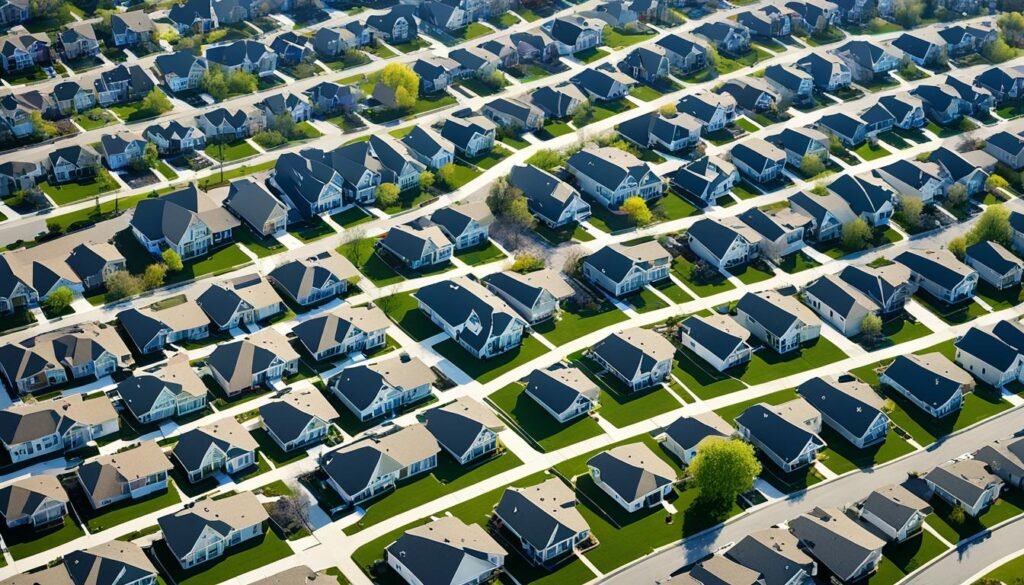Roof size can vary a lot, and this impacts your budget. Knowing how to measure and estimate your roof is key. This article will show you the steps to get it right. Get ready to learn about roof pitch and how it changes the game, plus how to figure out costs for materials and labor. We’ll use helpful tools like the Roofing Area Calculator to make things clear.
Key Takeaways
- Understand the impact of roof pitch on cost, area, walkability, drainage, and material selection.
- Learn to accurately calculate your roof’s square footage using the Roofing Area Calculator.
- Discover the importance of accounting for roofing material waste and high-wind area requirements.
- Explore the factors that impact labor costs, including hourly rates and project complexity.
- Identify commonly underestimated items like hip/ridge cap and underlayment costs.
Calculating Roof Area: A Comprehensive Guide
Getting the roof area right is key to knowing your budget. The roof area calculator is super handy for basic estimates. For tricky shapes, though, measuring each part and then using the calculator is best for accuracy.
Roofing Area Calculator
The roofing area calculator gives a close guess of the roof’s size. It works well for simple roof types. But for roofs with more detail, like dormers or different slopes, manual measurements are better for the exact size.
Roof Pitch and Correction Factors
The roof pitch impacts the roof’s actual size. It’s a ratio that shows the steepness. A steeper roof needs special materials and more labor, boosting costs.
For the right size, look at the Roof Pitch Correction Factors table. It shows how to adjust for the pitch and get the true measurements for your material needs.
| Roof Pitch | Correction Factor |
|---|---|
| 4/12 | 1.04 |
| 5/12 | 1.06 |
| 6/12 | 1.08 |
| 7/12 | 1.11 |
| 8/12 | 1.14 |
| 9/12 | 1.18 |
Multiply the basic area by the right correction factor. This gives you the true roof area. It’s crucial for knowing your material and cost needs.

Estimate roof: Material and Labor Costs
First, find out exactly how big your roof is. Then, estimate the cost of materials and workers. In the U.S., the main roofing materials are shingles, membrane roofing, and ceramic tile. They each last different amounts of time and cost varies.
Roofing usually costs between $2 and $4 for each square foot. This includes both materials and labor. You can choose a local contractor to figure out the exact costs. They will tell you the specific material and labor costs per square foot or square meter. Or, if you can’t get in touch with one, you can guess the material costs and then multiply by 2.5 to add the labor costs.
Don’t forget about extra costs, like removing the old roof and waste disposal. This makes sure your budget covers the whole project cost.
Roofing Material Costs
The price of roofing materials changes depending on the type and quality. Here’s the average cost for different types of materials:
- Asphalt Shingles: $5,840 to $10,100
- Metal Roofing: $10,245 to $41,640
- Tile Roofing: $10,665 to $20,900
- Wooden Shakes/Shingles: $10,230 to $15,500
- Slate Roofing: $39,925 to $54,020
Roofing Labor Costs
Labor costs are another big part of the overall roofing price. For shingle roofs, expect to pay between $2.00 and $3.50 per square foot. Metal roofs cost more, between $4.00 and $8.00 per square foot. The size of the team and how fast they finish can also change labor costs.
| Roofing Material | Labor Cost per Square Foot |
|---|---|
| Asphalt Shingles | $2.00 – $3.50 |
| Metal Roofing | $4.00 – $8.00 |
| Wood Shakes/Shingles | $4.00 – $8.00 |
| Flat Roofing | $2.00 – $4.50 |
The final cost of your roof will vary. It depends on the roof size and shape, your location, and any extra work needed. This might include underlayment, decking, and flashing.

“Roofing labor costs are affected by factors like roof slope, accessibility, geographical location, and additional services like underlayment, decking, and flashing.”
Conclusion
We’ve given you the tools and insights to figure out your roofing project’s size and cost. You can now use the Roofing Area Calculator and Roof Pitch Correction Factors easily. By knowing the usual costs for materials and labor, you can start planning your roofing project without worry.
Remember, roofing costs change with things like how complex your roof is and the materials you pick. The skill of your roofing contractor also matters a lot. Getting several estimates from trusted local roofers, like Local Roofer Pros, is smart. It helps you make the best choice.
With the right facts and help, your roof estimation will go well. Choose quality roofing solutions and work with skilled pros. This way, you’ll feel sure about your roofing project, from planning to finish.
FAQ
How can I accurately calculate the area of my roof?
What is roof pitch and how does it affect my roofing project?
How can I estimate the material and labor costs for my roofing project?
What should I consider when planning my roofing project?
Where can I find a local roofing contractor to get a precise quote?
Source Links
- https://www.calculator.net/roofing-calculator.html
- https://roofsnap.com/blog/roof-estimating-101/
- https://www.wikihow.com/Estimate-Roofing-Materials
- https://www.size.ly/calculator/roofing-calculator
- https://www.linkedin.com/pulse/decoding-roof-measurements-comprehensive-guide-restorationbuilders-kawsc
- https://roofr.com/blog/roof-measurements
- https://roofingcalculator.com/roof-replacement-cost
- https://homeguide.com/costs/roofing-labor-cost
- https://www.thisoldhouse.com/roofing/reviews/new-roof-cost
- https://gandbrosroofing.com/blog/essential-checklist-what-should-my-roof-replacement-estimate-include/
- https://180contractors.com/blog-understanding-roof-replacement-estimates/
- https://www.gobuildee.com/post/how-to-estimate-roofing-cost
